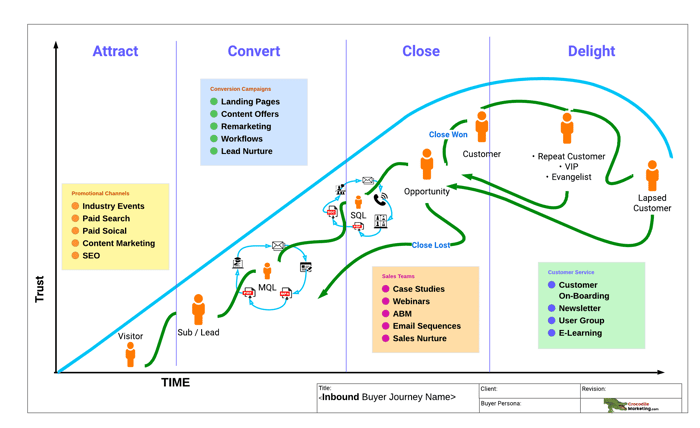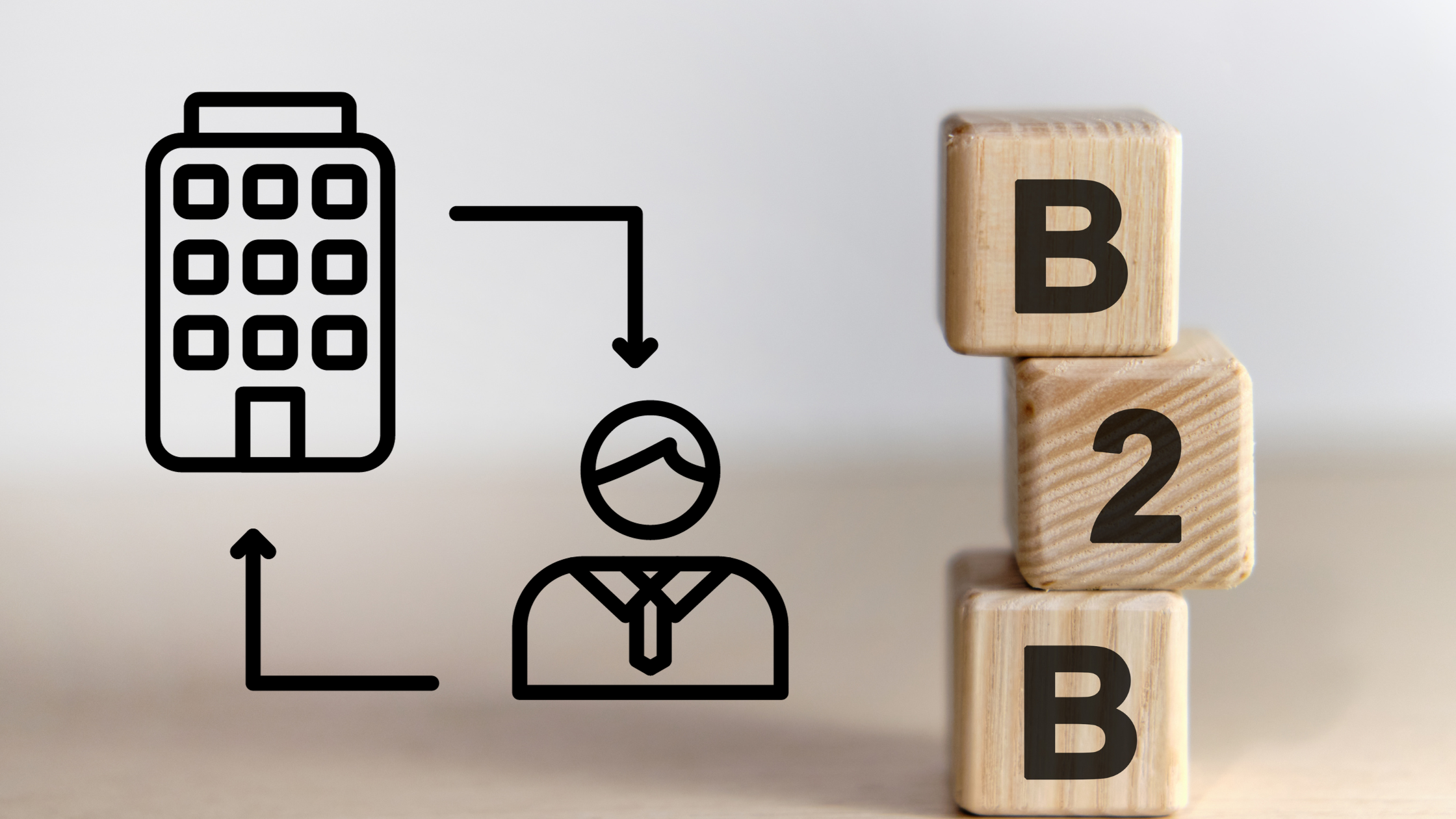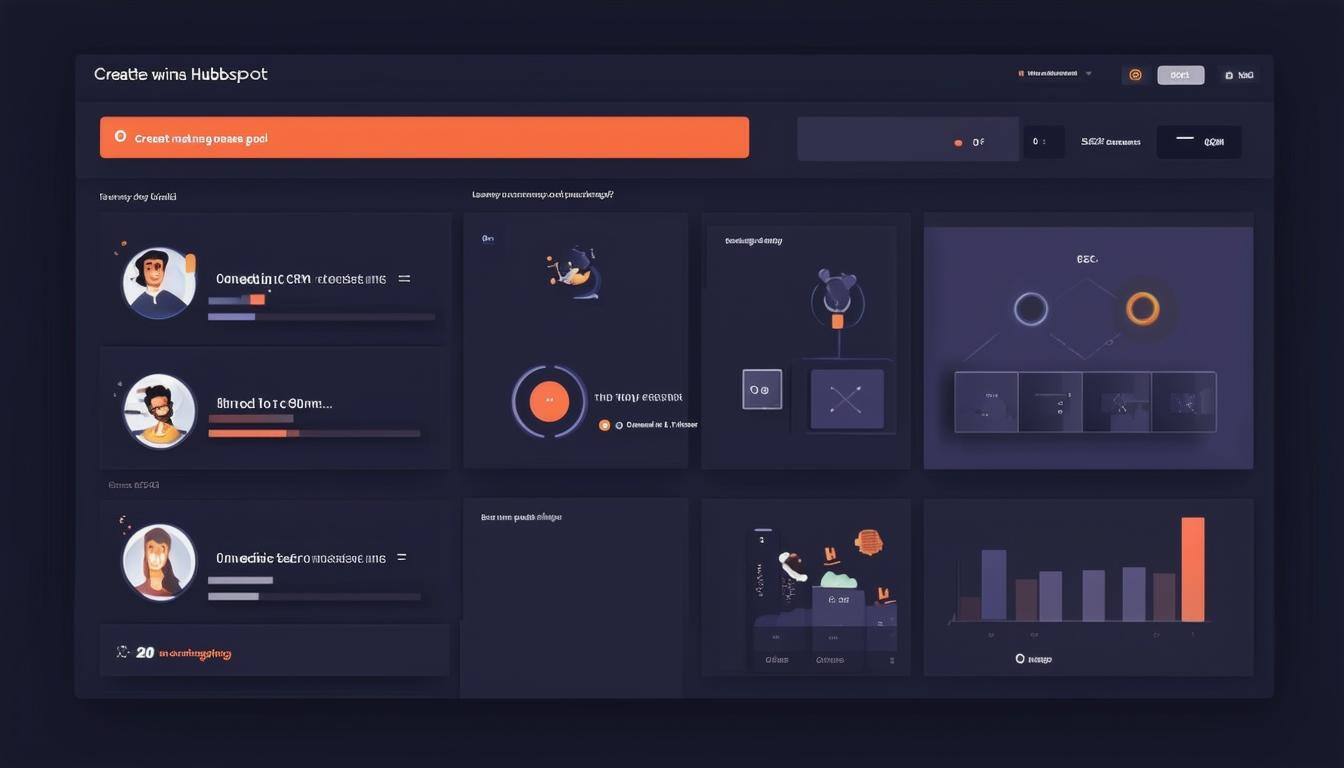Customer journey map: How-to understand your customer buying journey
As a business owner or marketing manager, it's essential to understand your customers' buying journey. By mapping out the steps they take, from becoming aware of a problem or need, to making a purchase, you can learn how to better serve them.
A customer journey map provides an overview of the steps customers take as they move through the sales funnel. It can also help you identify potential areas for improvement in your marketing and sales efforts. In this post, we'll share how to create a customer journey map and what to keep in mind as you do so. Let's get started!
Define what a customer journey map is and its key components
A customer journey map is a visual representation that illustrates customer interactions and their experiences at each stage of the customer lifecycle. The customer's journey can take many paths and involve many different touch-points as they interact with a business, so this map wraps all of these customer interactions into one document.
With a customer journey map, businesses can identify which customer journeys lead to successful outcomes and which ones need fine tuning.
To do this, it is important to start by
- selecting and understanding your buyer’s persona — their interests, motivations, and values — so you can tailor the journey accordingly.
- Once they enter your funnel or website, all possible touch-points need to be identified (e.g. landing page visits, page views, etc.).
- Customer emotions should also be considered at each touchpoint. What action do you want them to take? How would that make them feel?
This will help create a successful customer journey. Additionally, it’s important to assess what resources are available in order to implement these steps.
- Do you have a team that is able to support these efforts?
- Are there additional human/tech resources needed?
- Are there any automated processes that can be incorporated into the journey?
Once all of this is established, finalise the customer journey by taking it yourself — walk through each step as if you were an actual consumer so all potential issues can be addressed prior to the launch.
By going through each part of the customer journey in detail, businesses can start to understand where potential opportunities lie and how they can better serve their customers.
Understand the different stages of the customer buying journey
Knowing the customer journey in marketing is key to understanding customer behaviour and creating customer-focused strategies to foster loyalty and generate sales.
What are the 4 stages of the customer buying journey?
The customer buying journey can be broken down into four distinct stages: awareness, convert, close and delight.

- In the awareness stage, a potential customer recognises the need for a product or service due to a perceived problem or opportunity. This is where customers begin pre-research and are at the mercy of marketers’ ability to capture their attention.
- Following this, customers enter the convert stage in which they evaluate various options related to the solution of their needs.
- Once customers have decided on an option, they move onto the close stage, where they must make an actual purchase decision.
- To follow is the delight stage – it will be remembered by them long after the purchase has been discreetly filed away!
A great example of this would be when someone new moves into town and finds out about your local gym through social media – they become aware of their need for a place to exercise; they then consider their options before selecting yours as their provider; they then sign up and become a member; finally, if given great service and support during membership, it would lead to increased brand loyalty and delighted members who spread the word!
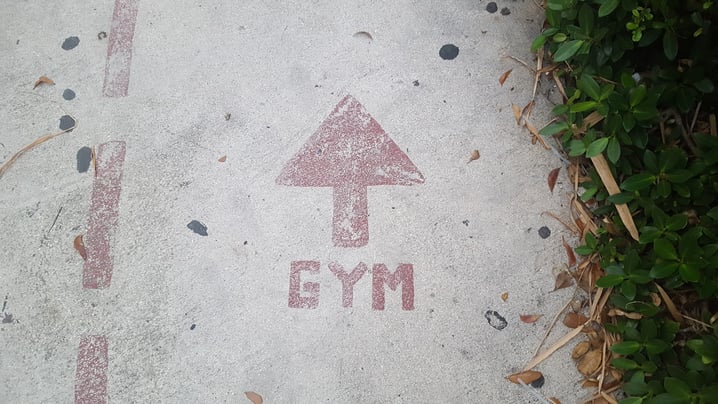
Understanding these steps helps marketers create personalised content that speaks to each individual customer's interests and needs during their journey.
How to use your customer journey map to improve your marketing strategy
Knowing how customers interact with your business along their customer journey can provide invaluable insight for marketing strategies. It lets you understand customer behaviour and discover how customer journeys influence customer decisions.
Using the customer journey map to recognise patterns of customer behaviour, you can identify areas in need of improvement and refine your strategy accordingly. This can help boost customer satisfaction levels and increase customer loyalty, leading to more successful marketing outcomes for your business.
Paying attention to customer journey mapping is an effective way to gain deeper knowledge of customer needs, which is essential to improve any marketing strategy.
The benefits of using a customer journey map in business
A customer journey map can be a great asset for any business which is looking to understand and improve the customer experience. It allows businesses to track the marketing journey of their customers, from initial marketing activities right through to the taking of an action, such as making a purchase.
By understanding the journey customers take, businesses can focus marketing campaigns on achieving their desired outcomes. They can also use this data to target marketing automation at individuals more precisely, helping to make sure they get content that is tailored and relevant to their interests and needs. In addition, this knowledge can also be used to continuously improve marketing campaigns, helping businesses reduce costs while improving conversion rates and customer loyalty.
The 8 steps to create your own customer journey map
Understanding a customer's journey is essential for any successful business; it helps to provide insight into their needs in order to create meaningful experiences. Creating a customer journey map can be a great way to do just that.
It is the visualisation of customers' interactions with your product at all stages, from initial contact to final purchase, and can help you identify where customers may become stuck or struggle in the process.
Learning how to create these maps can be a valuable tool when analysing customer feedback and optimising customers' experiences. With the right knowledge, any business can create their own customer journey map and capitalise on customers' behaviour and feedback.
1. Set clear objectives for the map.
When setting clear objectives for the map, it's important to consider the specific goals of your business and the main areas of focus you wish to explore. For example, do you want to understand how customers are interacting with your brand? Are you looking to identify potential pain points in their buying journey? Or perhaps you're curious what drives their purchase decisions?
It's also important to determine the right data sources and KPIs that will provide insights into customer behaviour. Depending on the type of data available - whether that's web analytics, surveys or customer feedback - these can provide valuable clues as to how customers interact with your product or service. Additionally, it can be useful to segment your target audience into different groups based on purchasing habits, demographic characteristics or other criteria. This can help pinpoint any common patterns or trends amongst them which could be useful for guiding future marketing campaigns.
Finally, when setting objectives for the customer journey map, it's important to define success metrics in order to measure progress over time. These could include sales conversion rates, engagement levels or any other key performance indicators that matter most for your business. With a clear set of objectives defined up front, this will ensure that the journey map results are relevant and actionable for improving customer experience and driving growth.
2. Select your target buyer persona and their goals.
Remember, a customer journey map tracks the experience of one buyer persona who's taking a very specific path with your business. In time, you will have many buyer journey maps for your product and services.

By studying the behaviour and preferences of your target personas, you can better understand their buying journey and create a more tailored experience. Having an in-depth understanding of each persona’s needs and wants allows you to segment them accordingly into different stages, giving you deeper insight into their decision making process.
By taking the time to research your target buyer personas, you can gain insights about how they make decisions, where they look for information, what influences their choices and how long it takes for them to commit to a purchase - all valuable information when mapping out a customer journey. It’s also important to consider the potential problems or obstacles that could occur along the way - such as abandonment of carts or difficulty in finding products - so that you can design solutions to address these issues.
Qualitative data from interviews, surveys and focus groups can provide invaluable insight into what customers are thinking during each stage of their journeys.
Creating buyer personas needn't be complicated: simply start with basic demographic information (age, sex, location) then get more granular by identifying job roles/titles, industries, goals/objectives, challenges and even pain points; this should give you enough data points to build on.
From there, delve deeper into each persona's buying habits and preferences; what channels do they access? What devices do they use? What type of content resonates most with them? Knowing this will help shape the customer experience both online and offline - allowing businesses to create experiences that truly resonate with their target audiences.
3. List out all the touchpoints.
Depending on the type of business, there can be many touchpoints that customers will experience with your company, from seeing an ad for your product or service to interacting with customer service representatives. Having an organised list of all the touchpoints allows you to understand exactly how customers move through their journey and where they are having difficulties, allowing you to create strategies to address those issues
Touchpoints can include anything that interacts directly with the customer. This could be digital means such as website visits, search engine marketing and social media ads, as well as offline methods like physical store visits and face-to-face interactions. Additionally, it’s important to consider other ways customers may be exposed to your brand such as via word of mouth or press coverage.
By knowing which stages of the customer journey are causing friction or delay, companies can use this knowledge to adjust their strategy accordingly and ensure customers have a pleasant experience throughout their buying journey with your company. With a comprehensive list of all the touchpoints present in a customer’s everyday life with your brand, companies are better equipped to optimise different areas of their marketing strategy and ensure top-notch results when it comes to conversions.
4. Identify the buyer’s emotions for each touch-point
This is a vital step in the customer buying journey because it helps marketers understand how a target audience feels when they interact with your brand. It also allows them to discover any pain points and potential areas of improvement along the customer journey map.
To properly identify a buyer’s emotions, you need to consider different channels, like website visits, social media messaging, display banners, email campaigns and more. By studying these channels carefully, you can then determine which ones are working better than others and pinpoint where customers tend to abandon their shopping carts or face other issues that might be preventing them from making a purchase. Additionally, this step enables you to identify what types of content resonate best with customers and use that data to create an effective marketing strategy.
Once these emotions have been identified, businesses can use this insight to create personalised experiences that are more likely to drive conversions by providing the right product or service at the right time with the right message.
5. Identify the human/tech for each touch-point (existing or new)
In order to ensure that customer needs and expectations are being met, it is essential to understand what resources (human or technology) need to be allocated to deliver a great customer experience.
For example, if your customer service team relies heavily on automated chatbots, then you’ll need to find out how they can be programmed and configured in order to provide the best service possible. If a website is used as a touch-point, then understanding who will create and design it, who will maintain and host it, and who will monitor its performance are all important considerations. Understanding how each touch-point should interact with your customers is crucial for optimising the customer journey.
Furthermore, it’s also important to consider which technologies may help streamline processes at each touchpoint; for instance, using artificial intelligence (AI) could help automate certain parts of the customer journey. By fully understanding what resources are needed at each stage of the journey, businesses can ensure that their customers have an optimal experience throughout their entire buying process.
6. Identify any automated processes that can be incorporated into the journey
Automating certain parts of the process has many advantages that can make the customer experience more efficient and pleasant. For example, automated processes like chatbots can reduce wait times, provide faster problem-solving support, and even act as virtual assistants to provide answers to frequently asked questions.

Additionally, automating payment systems ensures a secure and predictable transaction process while simultaneously minimising chances of errors or data loss. There are also several other ways automation can be used in the customer journey - from sending out automated emails at specific points in their journey to providing them with personalised product recommendations based on their past interactions.
Overall, incorporating automation into your customer journey map not only makes it easier for customers to navigate through their journey but can also help to improve overall satisfaction levels.
7. Finalise the customer journey by taking it yourself
By taking the journey yourself, you are able to better understand what a customer experiences at each stage. This can be done by signing up for your product or service on your own website and then going through each individual step until completion.
Doing this will allow you to see any possible points of friction or confusion that may prevent customers from making a purchase. It also helps identify potential areas where additional content or guidance may be beneficial. Additionally, it can help pinpoint areas to streamline processes in order to make the journey easier for customers and increase sales.
Taking the journey yourself can provide invaluable insights and inform decisions about how to optimise your customers' experience throughout their entire buying process.
8. Implementing
It is essential to ensure that the changes made to accommodate the changes in customer behaviour are properly implemented. This can include updating content, creating new offers, staff training and revising existing processes.
How does marketing automation improve customer journeys?
In today's digital age, customers expect personalised experiences throughout their journey, from initial contact to post-purchase engagement. It is essential for businesses to have a comprehensive view of the customer in order to provide these experiences. Marketing automation can help companies achieve this by providing an end-to-end solution that helps them map out the entire customer journey.
Marketing automation offers an efficient platform that enables businesses to develop customised customer journeys. Through automation, companies can design and implement campaigns that are tailored to individual customer needs and preferences based on their data points and behaviour patterns. This helps ensure that customers receive the right message at the right time in order to maximise their engagement with the brand. Additionally, automation can help target specific demographics or geographic regions better so businesses can be more precise when crafting campaigns.
On top of providing automated solutions for targeting customers within a particular campaign, marketing automation platforms also offer tools for personalising content within each stage of the customer journey map. For example, marketing automation can be used for segmenting audiences into specific segments based on their interests or purchase history so that personalised content can be delivered at each touchpoint along the customer’s path. Automation even supports changes in content based on real-time events, such as product releases or seasonal promotions; this ensures that customers are only seeing relevant information at any given time during their entire experience with your brand.
Furthermore, marketing automation allows businesses to track important metrics like page visits, signups, and purchases in real time; this gives them valuable insights into how customers are engaging with their brand across all channels and provides guidance on how to optimise future campaigns accordingly. That said, automated systems also allow companies to collect feedback from customers whom they may not otherwise have access to while also enabling quick responses through automated replies thanks to the machine learning capabilities.
How can you automate customer journeys?
Marketing and sales automation can be an invaluable tool in improving customer journeys. Automation provides businesses with the ability to efficiently manage, track, and analyse customer data that is critical for delivering better customer experiences. Here are some of the most common marketing and sales automation tools to help improve customer journeys
1. Lead Scoring: This tool allows companies to quickly review customers’ engagement levels with their brands and prioritise leads based on how likely they are to convert into paying customers. Lead scoring can be based on a variety of criteria such as demographic information, website visits, email campaigns, etc., which helps businesses focus their efforts on those most likely to purchase products or services
2. Customer Data: Automation for collecting, analysing, and managing customer data from multiple sources across channels. It enables businesses to gain insights into consumer behaviour and preferences so they can better tailor their marketing strategies for improved conversions. You can track customer lifecycle stages, segment customers more effectively by behaviours, and evaluate how different marketing strategies are impacting each stage of the journey
3. Personalization: Allows companies to deliver personalised content that resonates with individual customers at different stages of their buying journey. By targeting specific audiences through tailored messages based on segmented data points collected along the way, companies can maximise conversions while providing customers with the best possible experience throughout the entire journey.
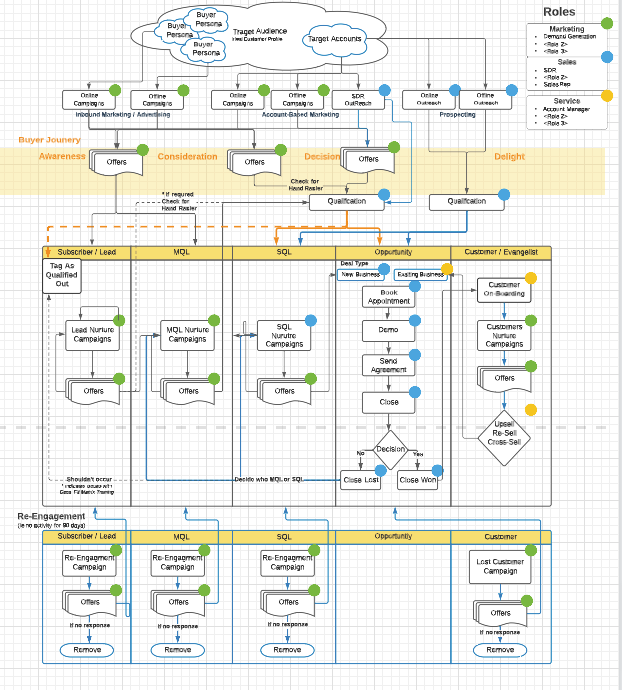
4. Chatbots: Chatbots offer helpful interactions between brands and customers by utilising natural language processing (NLP.) technology to understand human conversations and provide appropriate answers in real time. They also play an important role in driving sales by providing quick access to product information and helping customers find relevant solutions faster than ever before
5. Automated Email Marketing: Automated email marketing makes it easy for businesses to create targeted emails that are sent out automatically at predetermined intervals based on specific customer criteria or behaviours such as abandoned carts or purchases from particular categories of products/services. This helps ensure that each contact receives relevant messages tailored specifically for them throughout their entire journey with your brand—from signups all the way through post-purchase follow up—increasing engagement rates while saving time and resources in the process.
Conclusion
A customer journey map is a visual representation of the different stages that a customer goes through when buying a product or service. By understanding these stages, you can create a marketing strategy that better appeals to your customers and increases sales.
Our team at Crocodile Marketing can help you create a customer journey map for your business and show you how to use it to improve your marketing efforts. Contact us today to learn more about this valuable tool and how it can benefit your bottom line.


